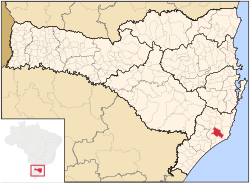Tubarão
| Município de Tubarão "Cidade Azul"
Tubarão
|
|||
|---|---|---|---|
|
Center with Museu Willy Zumblick
|
|||
|
|
|||
| Coordinates | 28 ° 28 ′ S , 49 ° 0 ′ W | ||
 Location of the municipality in the state of Santa Catarina Location of the municipality in the state of Santa Catarina
|
|||
| Symbols | |||
|
|||
| founding | May 27, 1870 | ||
| Basic data | |||
| Country | Brazil | ||
| State | Santa Catarina | ||
| ISO 3166-2 | BR-SC | ||
| Região intermediária | Criciúma (since 2017) | ||
| Região imediata | Tubarão (since 2017) | ||
| Metropolitan area | Tubarão | ||
| structure | 1 multiple district, 34 settlements; City: 23 Bairros | ||
| height | 9 m | ||
| Waters | Rio Tubarão | ||
| climate | subtropical, Cfa | ||
| surface | 301.8 km² | ||
| Residents | 97,235 (2010) | ||
| density | 322.2 Ew. / km² | ||
| estimate | 105,686 Ew. (July 1, 2019) | ||
| Parish code | IBGE : 4218707 | ||
| Time zone | UTC −3 | ||
| Website | tubarao.sc.gov.br (Brazilian Portuguese) | ||
| politics | |||
| City Prefect | Joares Carlos Ponticelli (2017-2020) | ||
| Political party | Partido Progressista (PP) | ||
| economy | |||
| GDP | 3,411,279 thousand R $ 32,904 R $ per capita (2016) |
||
| HDI | 0.796 (2010) | ||
Tubarão , officially Portuguese Município de Tubarão , is a city in the state of Santa Catarina in Brazil . It is located almost 150 kilometers south of the capital Florianópolis on the Rio Tubarão , which rises further south in the Campo dos Padres plateau in the Serra-Geral Mountains.
history
Tubarão was named after a local tribal leader named Tubanharô. The word comes from the Guaraní language and means wild or brave father . The name is not related to the Portuguese word tubarão for shark.
The first settlement, from which the city later developed, was founded in 1773 by soldiers halfway between Laguna and the highlands. In the 18th century, coal was discovered on the edge of the settlement. The hamlet became a stopping point for drivers who came with loaded mules for cheese, jerky meat and other products from the mountain region. The cargo was exchanged for products such as salt, dried fish and flour transported to Laguna by ship.
In 1870 the President of the Province of Santa Catarina passed Law No. 635, which gave the then Vila de Tubarão town rights and was separated from the town of Laguna. In the following years Italian and German immigrants came to this region. The railway line of Ferrovia Tereza Cristina connected the place to the rail network in 1884. Tubarão is also known as the Blue City. It was the writer, politician and journalist Virgílio Várzea who wrote about the beauty of the river, the enchanted blue sky and the mountains. The same river that enchanted the poet also caused death and destruction. The flood disaster of March 23, 1974 left deep marks in the history of the region. The river water had flooded about 80% of the urban area. The flood killed 199 people and left about 45,000 people homeless. It was one of the worst natural disasters in Brazil.
The city is the center of the Tubarão metropolitan area , to which 16 other municipalities in the area belong.
It has been the bishopric of the Tubarão diocese since 1954 and also the seat of the Universidade do Sul de Santa Catarina University .
The city is home to the Museu Ferroviário de Tubarão Railway Museum . The Termas da Guarda baths are in the vicinity .
The BR-101 , the longest federal highway in Brazil , runs through Tubarão in a north-south direction .
Sports
The oldest football club is Hercílio Luz FC , founded in 1918 , whose local rivals are Tubarão FC, founded in 1992, and Atlético Tubarão , founded in 2005 .
Personalities
- Walter Zumblick (1908–1989), regional historian of German descent
- Willy Zumblick (1913–2008), painter of German descent
- Jacinto Bergmann (* 1951), Archbishop of Pelotas, Bishop of Tubarão from 2004 to 2009
- Renan Bressan (* 1988), Belarusian football player of Brazilian origin
- Wilson Tadeu Jönck (* 1943), Archbishop of Florianópolis, from 2010 to 2011 Bishop of Tubarão
- Luiz Henrique Rosa (1938–1985), singer
- João Francisco Salm (* 1952), Bishop of Tubarão since 2012
Web links
- City Prefecture website (Brazilian Portuguese)
- City Council website , Câmara de Vereadores (Brazilian Portuguese)
Individual evidence
- ↑ Tubarão climate: average temperature, weather by month, tubarão weather averages. In: de.climate-data.org. Retrieved November 1, 2019 .
- ↑ a b IBGE : Santa Catarina: Tubarão> Panorama. In: cidades.ibge.gov.br. Retrieved November 1, 2019 (Brazilian Portuguese).
- ↑ Joares Ponticelli 11 (Prefeito). In: com.br. Eleições 2016, accessed September 21, 2018 (Brazilian Portuguese).
- ↑ História. In: gov.br. Município de Tubarão, accessed September 21, 2018 (Brazilian Portuguese).
- ↑ Arquivo Público reúne centenas de documentos sobre a enchente de 1974. In: gov.br. Município de Tubarão, accessed September 21, 2018 (Brazilian Portuguese).






